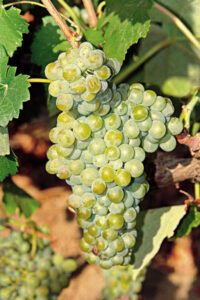Greek wines are fascinating, and Greece is emerging as a powerhouse of stylish wines on the international market. The Greeks, just as influential as the Romans, left cuttings of vines throughout Europe thousands of years ago. Unlike France, Italy, and Spain, which have long-established refined viticulture, Greece is adapting and improving on vinification techniques. This has much to do with their understanding of the thousands of indigenous varieties that can produce quality and exciting wines. Greece does produce wines from international varieties such as Cabernet Sauvignon and Chardonnay, but they are usually blended with native varieties and labeled as IGP or considered a table wine.
The Zafeirakis family has been engaged in viticulture in the Tyrnavos area for more than 100 years. Their Domaine Zafeirakis Malagousia 2018 is an exceptional example of the quality and excitement of Greek wines.
Christos Zafeirakis, the fourth generation to practice the family’s deep-rooted tradition, is considered one of the key advocates of finesse in Greek winemaking. His reputation is closely linked to the revival of the Limniona grape, but he also produces exceptional white wines from varieties such as Malagousia and Chardonnay.

https://winesofgreece.org/varieties/limniona/
Limniona is a rare and modern red grape variety that was rediscovered in Thessalia, specifically in the Karditsa and Tirnavos regions. This grape yields refined wines that are dense, rich, and high in acidity, but not overpowering. These wines have an extremely deep and vibrant red color, and a rich nose with aromas of dark fruits, spice, and earthiness. Limniona is one of the rare varieties that offer depth and complexity without being heavy or dull. Its wines are truly a testament to Greece’s potential in the winemaking industry.

https://winesofgreece.org/varieties/malagousia/
Malagousia, on the other hand, is considered the Cinderella of Greek grapes. Almost extinct, it was fortunately revived in the 1970s by a professor. This white-skinned grape variety is grown throughout Greece, with Central Macedonia being the most prominent region. Despite the variety’s different expressions throughout Greece, Malagousia wines tend to be rich and full-bodied, with relatively low acidity. They offer a broad spectrum of aromas ranging from flowers and blossoms to citrus fruits such as lime and orange, complemented with herbaceous notes such as mint and basil. There are both oaked and unoaked examples of this grape variety, and it is often blended with other local or international varieties to enhance its aroma, character, and richness.
Limniona and Malagousia are two excellent grape varieties that showcase the diversity and quality of Greek wines. These grapes are part of a rich winemaking heritage in central Greece and are among the factors contributing to Greece’s emergence as a powerhouse of stylish wines on the international market. With their unique and exciting flavors and aromas, these grapes have much to offer to both wine enthusiasts and novices alike.
The color of Domaine Zafeirakis Malagousia 2018 is medium gold with a hint of green at the rim. On the nose, there is a high intensity of white-fleshed fruits such as pears, mangos, peach, citrus fruit of lemon zest floral with fresh roses and jasmine and orange blossom, a hint of mint and sage, along with the smoke. On the palate, it is dry, with medium acidity and alcohol, full-body, high intensity with green pears, white peaches, honeydew melon, apple geranium, sweet basil, mint, crushed rocks, and smoke lemon, and grapefruit zest mouth-coating texture, and a medium-plus finish. This is a very good wine with an outstanding balance of fruit and acidity. It’s pleasantly refined from alcohol bringing out its aromatics. Even though it’s vinified in stainless steel, the varietal and the use of natural yeast give character to the wine. The label indicates it’s an IGP and not at the PDO level. Chardonnay may have been used, thinning it out for a less-than-remarkable wine.
Domaine Zafeirakis Malagousia 2018 is an exquisite white wine that displays the unique character of the Malagousia grape. The winemaking techniques used by Christos Zafeirakis create a wine that is perfumed but with a mineral core.

Domaine Zafeirakis
The Zafeirakis family’s commitment to viticulture in the Tyrnavos area for over a century has yielded exceptional wines, and this Malagousia 2018 is no exception. It is a testament to the exciting potential of Greek wine on the international market and I would encourage anyone to become an admirer of Greek wines.
Ciao! I hope you enjoyed the article about Domaine Zafeirakis Malagousia 2018
Please comment below. I Love your feedback. Thank you and remember Taste Small Live Big!
Follow me on Instagram@epicurean.angel

